If there is one jam with devotees, it is citrus trees jam... or rather marmalade*, the term reserved for it. Whether prepared solely from oranges or by including other winter citrus trees, this marmalade is simply a marvel on morning toast! Reputed to be difficult and slow to prepare, I finally decided to cook it and share my secrets to get it right first time.
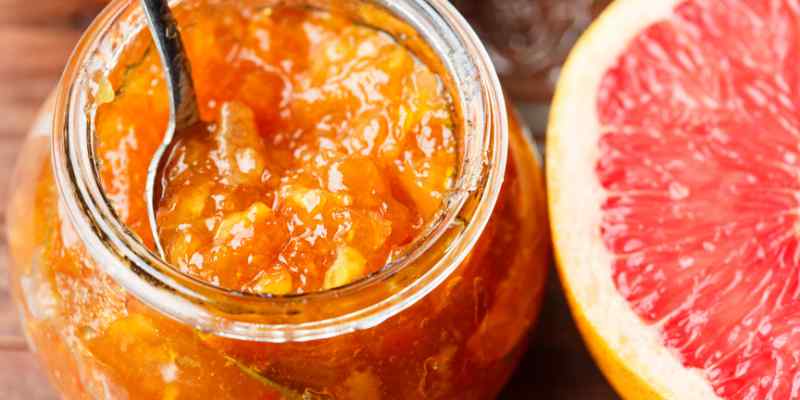
Which citrus trees to choose?
When it comes to citrus trees jams, as with many homemade jams, you can allow yourself a fair amount of liberty, since there are so many citrus trees that blend well together.
I wanted to recreate the flavour of a famous English marmalade brand whose name I will not mention, which makes delicious marmalades using the traditional fruits found in citrus trees marmalades.
It is of course important to take bitterness into account before attempting this jam, so as not to have to compensate with too much sugar. Use therefore sparingly and with precise dosing the most bitter fruits such as grapefruit, bitter oranges (from the bitter orange tree) and also lemon and citron. For example, I replaced yellow lemon with lime to obtain more acidity and a flavour I adore.
* The term marmalade (from Portuguese marmelada) technically defines a cooking of citrus trees only, whole (juice, flesh, bark of the fruits and sugar).
Important : use only untreated fruit for this recipe. Citrus trees are in fact, along with apples, among the most treated fruits in the world, via fungicidal and insecticidal agents such as Thiabendazole. Even if fruit are washed thoroughly before preparing, since their bark will be used for this recipe it is essential to use organic fruit (which contain, however, a little less).
Preparation time
It is often because of preparation time that people hesitate to tackle citrus trees jam. Fruit are indeed long to trim and to cut, and require soaking and blanching time. Most of my recipe books recommend a three-day preparation, while some magazines reduce it to one or two days. I tried a mixed approach by simply reducing maceration times.
Ingredients and equipment
For this recipe I chose four citrus fruits: orange, grapefruit, clementine and lime. For a first attempt I opted for small quantities, about one kilo of fruit.
- 4 organic oranges (about 600 g)
- 1 organic grapefruit (250 g)
- 1 organic lime (70 g)
- 2 organic mandarins (100 g)
- 1 small piece of apple or quince (facultative)
- granulated sugar
- 1 large saucepan or stockpot
- 1 large mixing bowl
- 1 vegetable brush
- 1 needle
- 1 jam funnel and a ladle
- 1 stamen (facultative)
- 4 jam jars with lids + labels
The recipe
- Start by preparing the citrus fruits: after brushing them with a small vegetable brush under a filament of cold water, dry them and prick their skin at regular intervals using a large needle. Blanch the fruit for 3 minutes in a stockpot of water brought to the boil, then remove them and place in a large mixing bowl, covering with cold water, weighting them down so they do not float. Leave the fruit to soak overnight, minimum 12 h (I soaked them 17 h), which will soften their skins;
- The next day, remove the fruit, drain, pat dry and cut into small pieces, removing pips (to be tied in the stamen) and trimming off the two ends that are too thick. This is the longest operation of the recipe, because you must cut the flesh into pieces, but also deal with the barks of the citrus trees to remove the white part beneath the zests, which is quite bitter. I worked in two stages: first the fruit flesh (removing the endocarp, that thin membrane around the segments, as one does when segmenting supremes), then preparing the barks.
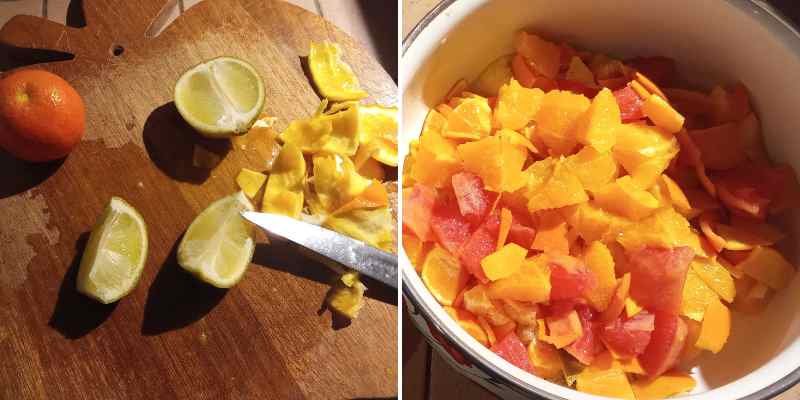
- Prepare the barks: with the blade of a sharp knife, peel away the white from oranges, clementines and grapefruit, keeping only the barks with no white, then cut them into small pieces.
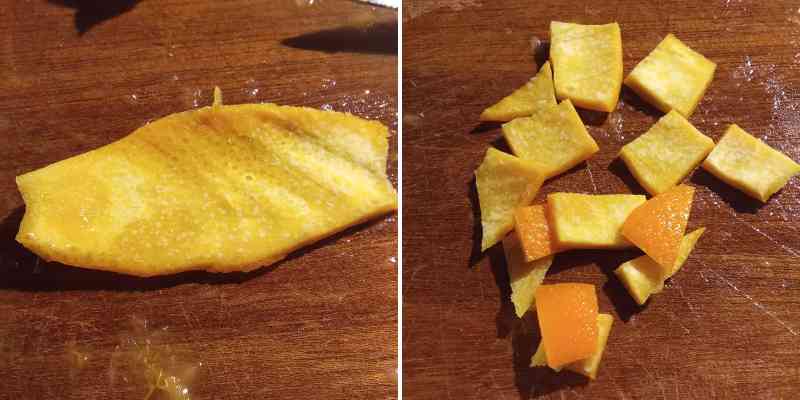
- Place the fruit and their barks in a large saucepan, adding sugar equal to the weight of the prepared fruit (about 900 grams of sugar for this quantity of fruit). Add a piece of quince or apple if, like me, you collected few pips. Mix and cook at a low simmer for 10 minutes.
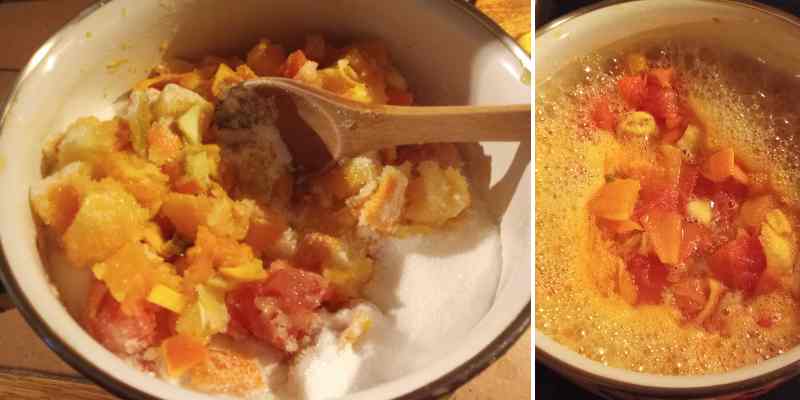
- Let cool and place everything in the fridge for a whole night. The next day (day 3 then, still with me?), pass the mixture through a stick blender to obtain a coarse pulp. Cook the jam again, skimming lightly, for 15 minutes. We are almost there...
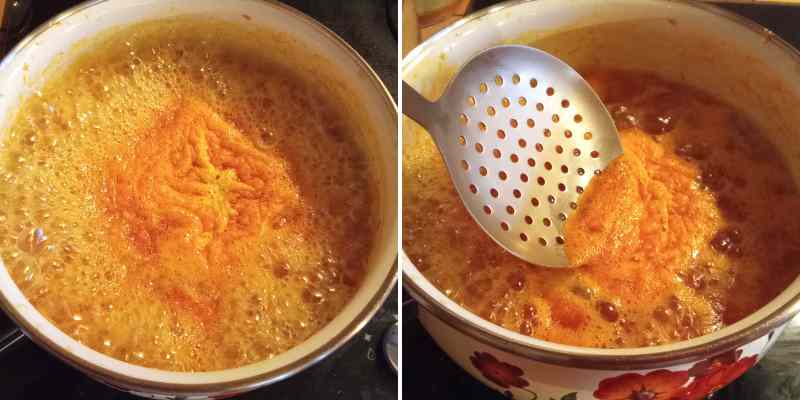
- Meanwhile, scald jars and lids for a quick sterilisation and dry them on a clean tea towel. Fill jars using a jam funnel or with a small ladle. Screw lids on and turn jars upside down to create a vacuum. Turn jars right way up when cooled and label with date. Ready to eat at breakfast from next day!
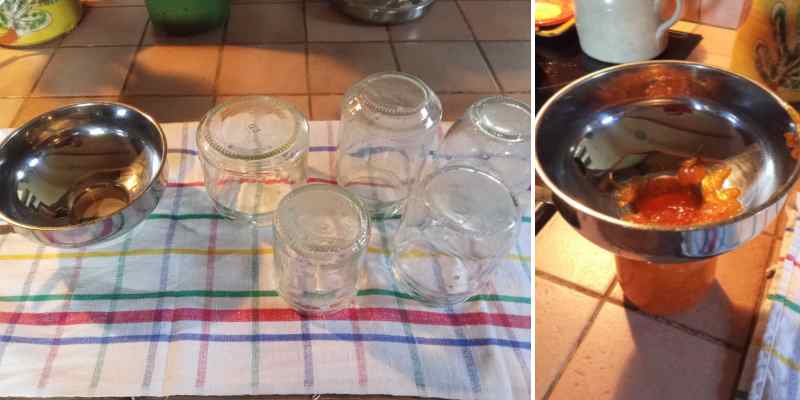
My tips
- Marmalade is therefore long to prepare, that is a fact, and I have heard that single-day simplified versions are not so bad. For a first attempt I nevertheless wanted to respect a certain maceration time and the double cooking. Besides, making this jam in autumn or winter is also an excuse to take your time, a bit like when preparing a brioche warm at home. That is also part of the pleasure of making marmalade! I found it ultimately even more rewarding than making "regular" fruit jams.
- I started by cooking small quantities of fruit. Of course you can prepare a larger quantity to obtain more jars. However, that will increase the time needed to prepare the zests.
- Adding a small piece of apple or quince helps increase pectin level (although citrus trees already have among the highest pectin content).
- You can also blend the fruit before cooking. Blend well to obtain a texture in which the barks will be chopped. I may try next time the technique of cutting zests into thin strips (the English-style "fine cut marmalade"), but that seemed to add more time to the preparation for a first attempt.
- In my view citrus trees marmalade does not require the addition of spices (you often see cinnamon or star anise in recipes, sometimes mixed spice; I also found a version with curaçao, and you can twist it with whisky as in Scottish recipes). Its natural perfume is pronounced enough and I personally like to retain only the aromatic power of the fruit, their acidity and their bitterness.
Further reading...
I adapted this recipe slightly from several books I had at home, notably the excellent book "Confitures et bocaux gourmands" by Marie Abadie, food journalist. It is no longer in print, but can certainly be found second-hand if you look!
You can learn much more about the history and different techniques of citrus trees marmalade by consulting this very good article(in French) by Sophie Brissaud, also a food journalist in various media.
Do you like citrus trees on your toast? Also try my lemon curd, a lemony treat straight from England that elevates lemon, which I like to give at Christmas.
Other winter jams are prepared from autumn: Ingrid gives her recipes for chestnut jam and grape jam; Virginie talks about kumquat jam in Fruits for original jams (article in French).
Please feel free to post on this article to share your own home secrets and the variations you know!
































Comments